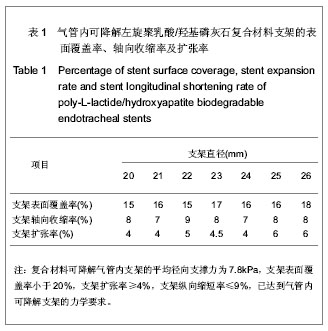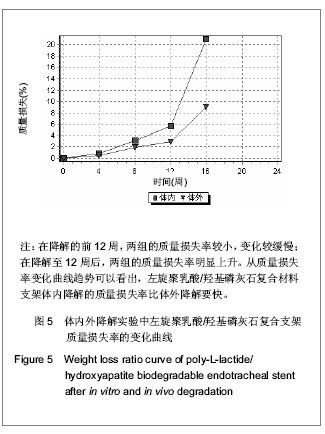| [1] Bond CJ.Note on the treatment of tracheal stenosis by a new T shaped tracheotomy tube.Lancet.1891;1:539.[2] Langer R,Vacanti JP.Tissue engneering.Since. 1993;250: 920-926.[3] Pollok JM,Vacanti JP,Future materials for foot surgery.Sem in Pediatr Surg.1996;5(3):191-196.[4] Liu Y,Sun Y,Zhou N,et al. Nitinol alloy endotracheal stent for treatment of tracheal stenosis.Chin Med J.1997;11(7):540-542. [5] 刘阳,郭锦芳.镍钛记忆合金支架治疗气管狭窄的实验研究及临床应用[J].中华外科杂志,1993,31(5):267-268.[6] 刘阳,孙玉鹗.镍钛记忆合金气管腔内支架的实验研究[J].中华胸心血管外科杂志,1995,11(4):233-234.[7] 崔福斋.可降解医用介入支架的研发进展[J].国外塑料,2005, 23(11):58-64.[8] Free CE,Vunjak-novakovic G,Iron KJ.Biodegradable polymer scaffoids for tissue engineering. Biotechnology(NY). 1994; 12(7):689-693.[9] Kulkarni RK,Pani KC,Neuman C,et al.Polylatic acid for surgical implants.Archs Surg.1966;6(3):839-843.[10] Miller RA,Brady JM,Cutright DE.Degradation rates of oral resorbable implants(polylactates and polyglycolates):rate modification with changes in PLA/PGA copolymer ratios.J Biomed Mater Res.1977;11(5):711-719.[11] 宋存先.可降解与吸收材料—生物医用材料[M].天津:天津大学出版社,2000:50.[12] Weisberger EC,Eppley BL. Resorbable fixation plates in head and neck surgery.Laryngoscope.1997;107(6):716-719.[13] 祖恩峰,杨青芳,马爱洁,等.生物医用材料聚L-乳酸的生物相容性及降解性能研究[J].中国胶粘剂,2005,14(9):7-10.[14] Verheyen CCPM,Dhert WJA,Petit PLC,et al.In vitro study on the integrity of a hydroxylapatite coating when challenged with staphylococci.J Biomed Mater Res. 1993;27:775-781.[15] Shikinamn Y,Hata K,Okunu M.Ultra-high-strength resorbable implantsmade from bioactive ceramic particles/polylactide composites. Biocramic Proc Int Symp CeramMed.1996; 9: 391-394.[16] Jones NL,Williams DF. Poly [L-Lactide] and Poly[L-Lactide] Ceramic filled Composites: A Long Term in- vivo / in-vitro Degradation Study. Trans.5th world Biomaterials congress. Toronto.1996,Ⅱ:441.[17] 江东亮,漆宗能.纳米复合材料-复合材料[J].天津:天津科技大学出版社,2000:262-276.[18] Skavtsas VI.Biomaterials and bone mechanotransduction. Biomaterials.2001;22(19):2581-2593.[19] Suchanek WL,Shuk P,Byrappa K,et al. Mechanochemical-hydrothermal synthesis of carbonated apatite powders at room temperature.Biomaterials.2002;23: 699-714.[20] Liu Q,Win JR,Bakker D,et al.Polyacids as bonding agents in hydroxyapatite polyester-ether (polyactiveTM30/70) composites.J Mater Sci Mater Med.1998;9:23-30.[21] Horenstein LA.Chromosomal speciation and phenotypic evolution in the house mouse.Micro Tropical Med.2003; 275:99-112.[22] Feng LY,Li SP,Yan YH.The Effect of CaCO3 and TiO2 Nanometer Particles on A549 and L929 Cells.Biocermics. 2000;13:325-328.[23] 夏东,刁路明,杨飞,等.无机纳米粒子对人肺癌细胞A549和小鼠成纤维细胞L929生物学特性研究[J].湖北医科大学学报,2000, 21(2):109-111.[24] Kim YH,Park SW,Lee CW,et al.Comparison of sirolimus-eluting stent, paclitaxel-eluting stent, and bare metal stent in the treatment of long coronary lesions. Catheter Cardiovasc Interv.2006;67(2):181-187.[25] 李毅,张佩华,王文祖,等.新型针织结构人工气管支架的开发及其力学性能初探[J].产业用纺织品,2002,20(12):23-26.[26] Stack RS.Biodegradable systems.In,Bake RW,ed. Controlled release of biologically active agents.New York:John Wiley and Sons.1987:84.[27] Swaua T.Short and long-term vascular tissue response in the Duke bioabsorbable stent.JACC.1993;21(suppl):484.[28] Lincoff AM,Furst JG,Ellis SG,et al.Sustained local delivery of dexamethasone by a novel intravascular eluting stent to prevent restenosis in the porcine coronary injury model.J Am Coll Cardiol.1997;29:808-816.[29] Yamawaki T,Shimokawa H,Kozai T,et al.Intramural delivery of a specific tyrosine kinase inhibitor with biodegradable stent suppresses the restenotic changes of the coronary artery in pigs in vivo.J Am Coll Carddiol.1998;32:780-786.[30] Tamai H, Igaki K,Kyo E,et al.Initial and 6-month results of biodegradable poly-l-lactic acid coronary stents in humans. Circulation.2000;102:399-404.[31] Korpela A,Aarnio P,Sariola H,et al.Bioabsorbable self-reinforced poly-L-lactide, metallic and silicone stents in the management of experimental tracheal stenosis.Chest. 1999;115(2):490-495. [32] Leenslag JW,Penning AJ,Bos RRM,et al.Resorbable materials of poly (L-lactide) VI.Plates and screws for internal fracture. Biomaterials.1987;8: 311-314.[33] 刘建伟,赵强.万昌秀.医用聚乳酸体内降解机理及应用研究进展[J].航天医学与医学工程,2001,14(4):308-312.[34] 顾其胜,侯春林,徐政.实用生物医用材料学[M].上海:上海科学技术出版社,2005:87.[35] 吴兰亭,沈正荣,朱家蕙,等.DL-聚乳酸微球大鼠体内的降解[J].生物医学工程学杂志,1994,11(2):98.[36] Martinez J,Sanchez T,Moreno JJ. Regulation of prostaglandin E2 production by the superoxide radical and nitric oxide in mouse peritoneal macrophages. Free Radic Res.2000;32(4): 303-311.[37] Rose ML,Rusyn I,Bojes HK,et al.Role of Kupffer cells and oxidants in signaling peroxisome proliferator-induced hepatocyte proliferation.Mutat Res.2000; 448(2):179-192.[38] Chong IW,Lin SR,Hwang JJ,et al.Expression and regulation of macrophage inflammatory protein-2 gene by vanadium in mouse macrophages. Inflammation.2000;24(2):127-139. [39] Li SM,Mc Carthy S.Further investigations on the hydrolytic degradation of poly(DL-lactide).Biomaterials.1999;20(1): 35-44. |




.jpg)
.jpg)
.jpg)
.jpg)
.jpg)